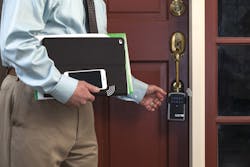Security managers everywhere are tasked with managing many variables in order to ensure their facilities and operations are protected with the proper level of security. These challenges run a wide gamut, and often require solutions spanning video surveillance, cybersecurity, fire protection, intrusion detection, access control and more. Mitigating a myriad of risks means checking off a whole lot of boxes. Thankfully, significant and ongoing advancements in technology are delivering sophisticated security solutions to help security managers sleep a bit better at night.
Despite these advances, hidden gaps and areas of vulnerability can often be overlooked. It is crucial for security managers to be proactive in assessing any possible gaps that may exist and implement additional access control solutions to mitigate them.
Identifying 5 Areas of Vulnerability
Every organization is faced with its own specific set of pain points. While some are universal, others are unique to the individual facility’s setup and operation. Areas that can be particularly susceptible to access control gaps and vulnerabilities include perimeter and building access points, critical equipment and tools, physical plant and infrastructure, hosting and technology access points, and storage areas. Scalable electronic access management solutions (EAMS), however, have proven effective in eliminating these security gaps and mitigating risk in potentially vulnerable areas.
1. Perimeter and Facility Access
Perimeter protection is the first line of defense in securing a facility of any kind. Keeping unauthorized individuals restricted is the main goal of any access control measure, so ensuring the technology solutions in place are up to that challenge is key.
Organizations that rely on physical keys for access are often left to deal with the time and costs spent to change locks and replace keys when they are lost, stolen, duplicated or simply not turned in by former employees. Accountability can also be a challenge when keys are shared among personnel. For example, security managers may need to provide access to outside contractors or other service providers who need to enter a facility or secured area during non-business hours, which can be difficult to accommodate safely with physical keys. This can become especially complicated for an organization with facilities in multiple locations situated several miles apart.
2. Expensive Equipment and Other Sensitive Assets
Because many facilities house expensive equipment and other valuable assets, it can be detrimental to an organization if those assets are misplaced, stolen, or tampered with. These can include maintenance equipment, tools and supplies, IT equipment, data and servers, medical equipment and supplies and more. Depending on how critical the equipment is to perform a job, or how long it takes to replace, it can result in costly operational downtime and a loss in productivity. Aside from operational impacts, replacement cost and lead times can create financial burdens.
3. Setup Machines and Equipment Configuration Points
Additional operational inefficiencies can occur when access to equipment is not properly managed or easily accessible for students, faculty, staff and other authorized personnel. This is particularly true when access to necessary equipment or resources requires a manual request, approval and physical key hand-off process.
Equipment such as IT cabinets and other critical operation control points are essential to operations but can be sensitive to disruption due to unintentional access and tampering by unauthorized personnel. Access to this equipment should be limited, but not entirely restricted. A campus’ control rooms, for instance, need to be easily accessible by authorized personnel to facilitate maintenance and updates but also need to be protected against unauthorized access.
4. Hosting and Technology Access Points
Data breaches and other IT incidents have made headlines in recent years and have become increasingly commonplace, making limited access to sensitive network areas crucial. Senior-level management, security directors and their system integration partners are now tasked with implementing trusted solutions to protect their facilities, making it critically important to evaluate both physical security and cybersecurity considerations surrounding access points to servers, wireless access points and other network hardware.
In addition to limiting access to these sensitive areas, supervisors in charge of security should ensure that authorized personnel retains efficient access in order to maintain and diagnose relevant equipment in case of a disruption in operations.
5. Storage of Equipment and Materials
“Out of sight” should not translate to “out of mind.” Assets that are stored away often need more security than those that are in plain sight. For example, on-campus spaces like science labs, rehearsal spaces, athletic facilities and areas home to other student organizations are a common security risk, especially when considering all who may access those spaces, be it professors, students, teachers, coaches, etc. Security management must also stay mindful to secure department-owned stored equipment and consider who may need access to them and when, such as authorized employees, vendors and third-party contractors.
How to Close Security Gaps with Scalable EAC Solutions
As technology continues to facilitate more sophisticated access control solutions, security teams leveraging them are better equipped to secure critical assets, equipment, tools and access points. As a result, organizations across industries are realizing the security capabilities of EAMS are far more effective and efficient than those mechanical solutions can deliver.
As this trend continues, security professionals and their integration partners who haven’t made the transition should reevaluate areas where they typically place traditional mechanical solutions and work to convert them to electronic. Those who do will reap many benefits, including eliminating the need to manage physical keys. EAMS equipped with integrated software platforms can relieve many of the headaches associated with physical key management. Without the hassle and overhead costs of physical keys, EAMS enables authorized personnel to grant access to approved individuals, multiple users and even user groups, either on a temporary or ongoing basis and efficiently manage access to many doors and locks by many users. EAMS’ capabilities like back-up access entry methods for locks and lock boxes with manual, directional or numeric codes, are especially beneficial when securing important stored materials or restricted areas.
EAMS also allows security personnel to authorize permanent, temporary and/or periodic access to individuals. Contingent on an organization’s specific needs, security managers can organize personnel and visitor access by time, date, user or group. Many building badging systems simply are not flexible enough to accommodate periodic contractors or temporary guests, but EAMS can offer organizations a secure option to authorize access for “transient populations” such as employees, staff, contractors, vendors or guests. Additionally, if the EAMS utilizes Bluetooth technology, security directors and other authorized management personnel can remotely issue or revoke access in real-time.
Because today’s sophisticated EAMS have the ability to track just about anything, including evidence of who has accessed specific areas and when, facilities managers who are tasked with overseeing the security of their given sites can easily monitor operations from an overall perspective, as well as to identify individual areas of vulnerability.
Electronic access solutions are also increasingly more attractive as they can help curtail unwanted outcomes due to delayed response times to critical incidents. Because electronic solutions can flag issues and allow quick, authorized access to sensitive areas and assets, administrators can effectively monitor a situation and give employees secure access to critical equipment remotely. Additionally, the tracking capabilities of electronic solutions can also help significantly reduce the risk of theft or tampering of equipment and materials, by augmenting incident reporting data to better understand how an incident occurred. For example, if expensive equipment is stolen from a university’s science lab, EAMs can identify who last accessed the lab, time of last access, access method, if the lock had been tampered with, etc. This reporting information can be helpful for keeping professors, students and staff who access that space accountable, as well as for implementing appropriate security protocol and preventing future incidents.
EAMS are typically designed to integrate seamlessly with other existing security solutions so that security managers and the facilities they’re tasked with protecting are able to gain new insights, collect more robust reporting data across all security systems, and incorporate that into their overall access control measures to mitigate risk.
Choosing the Solution for Your Operational Needs
Every facility is different and faces its own security and access control challenges. Identifying areas of vulnerability and closing those unsuspected access control gaps is paramount in heightening security to its highest level. EAMS allows facilities to 1) efficiently manage access, 2) easily monitor access and access history 3) simplify security setup, and 4) confidently provide back-up access entry methods.
Access management remains a work in progress for corporate and industrial facilities everywhere. While technological advancements are helping all to identify security vulnerabilities and close the gaps, organizations must continue to work proactively to improve access control and the security of their operations. Luckily, there are cost-effective and scalable solutions available that can fit within nearly any budget and complement existing security solutions by providing compatible and robust reporting. It’s for this reason that EAMS continues to be a top choice for organizations seeking to implement state-of-the-art security.
About the author: Brad Smith, Director of Software Product Management, The Master Lock Company, has 18 years of experience in Software as a Service (SaaS), Internet of Things (IoT), e-commerce, and digital marketing. He plays a key role in managing the innovation and growth strategies for Master Lock® Vault Enterprise, an electronic access management software platform, which was designed to help organizations of all sizes more efficiently and effectively grant and manage access for the many locks and many users that exist within their organization, delivering a comprehensive access management system that integrates a robust software platform with Bluetooth-enabled security devices.
About the Author

Brad Smith
Director of Software Product Management, The Master Lock Company
Brad Smith, Director of Software Product Management, The Master Lock Company, has 18 years of experience in Software as a Service (SaaS), Internet of Things (IoT), e-commerce, and digital marketing. He plays a key role in managing the innovation and growth strategies for Master Lock® Vault Enterprise, an electronic access management software platform, which was designed to help organizations of all sizes more efficiently and effectively grant and manage access for the many locks and many users that exist within their organization, delivering a comprehensive access management system that integrates a robust software platform with Bluetooth-enabled security devices.
